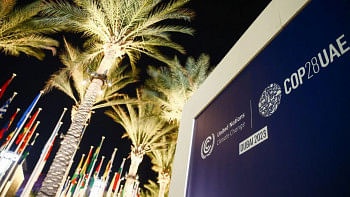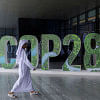The consensus and clashes COP28 brought up

By the time you read this commentary, COP28, the international climate conference in Dubai, would be drawing the curtains, following various groups engaging in intense negotiations to reach an agreement. It is almost certain that in the end, some progress would be made on some of the contentious issues, but a decision to act on key areas—the pace of emissions reduction, sources of funding, and clean energy choices—will most likely be kicked down the road once again for COP29.
At the beginning of the gathering, there was some good news and some bad. First, the good ones. A number of announcements aimed at decarbonising the energy sector were made at COP28 on December 2.
Sultan al-Jaber revealed that 49 oil and gas companies, among others, have pledged to dramatically reduce methane leaks to "near zero" by 2030. Methane is a more potent greenhouse gas than carbon dioxide. The COP28 Presidency also announced a renewable energy and energy efficiency pledge, which, along with the methane phaseout, is one of three components of a Global Decarbonization Accelerator (GDA).
The Green Climate Fund received an additional $3 billion commitment from the US, in addition to the $20 billion already committed by other countries. An undertaking by 117 countries, led by the EU, the US and the United Arab Emirates, also aims to triple renewable energy capacity worldwide by 2030 and double the "annual rate of energy efficiency" improvements. Finally, more than 20 countries signed a declaration with the aim to triple nuclear power capacity, currently at 370 gigawatts, to help achieve the "net zero" emissions target by 2050.
There were some disappointments and controversies, too. A few of the big names the organisers of COP28 were expecting, including presidents of the US and China and the pope, were unable to attend. It is well known that the US contributions are subject to the approval of Congress, and many of the Biden administration's global clean energy initiatives could be in limbo because the country is now mired in two wars.
On December 5, a The New York Times headline hit the nail on the head: "Finding Money to Fight Climate Crisis Is Big Obstacle at UN Summit." And it always has been. Earlier, UN Secretary-General Antonio Guterres was dismissive. "The promises made clearly fall short of what is required," he said.
"The world needs long-term money," said the prime minister of Barbados Mia Mottley last weekend in a statement on behalf of a coalition of climate-vulnerable countries. "We give thanks to the progress made but it does nothing but assuage consciences. Choosing between people and the planet is a false choice. The world has enough funds."
It has been known that all the steps discussed—whether it's tripling of renewable energy, adapting to the hazards of a hotter world, or compensating countries for the irreparable losses of climate change—require tons of money. As the Times aptly points out, unkept promises of aid have led to "mounting frustration" of leaders from the Global South. "Money is crucial to restoring confidence."
The media has played up the comments made by al-Jaber, who got enmeshed in a verbal duel with Mary Robinson, the former Irish president. On November 21, during an online discussion, al-Jaber allegedly declared there was "no science" behind the call to urgently phase out fossil fuels as a way of limiting global temperature rise to 1.5 degrees and said it would send humanity "back to the caves."
However, after I listened to the entire video, it became clear that his response to Robinson was taken out of context. But that did not appease the sceptics.
"The recent comments from COP28 president show how entrenched he is in fossil fuel fantasy and is clearly determined that this COP doesn't do anything to harm the interests of the oil and gas industry," said Mohamed Adow, the director of Power Shift Africa.
There are some cracks among the participating countries on several unresolved stumbling blocks: emissions reduction and what to do about the massive shortfalls in climate finance and energy transition including renewables, energy efficiency, and decarbonisation.
COP28 brought up to the surface an ideological battle over how and how fast to end the use of fossil fuels. The outlook for meaningful progress is not very good. The controversy can also be characterised as a struggle between phase-out and phase-down schools of thought.
The EU, several Latin American countries and island nations back the 1.5 target, which implies a rapid phase-out. African countries back a phase-out but with a longer delay for developing nations.
Most developed countries, including oil producers such as the US, Canada, Norway and Australia, prefer phase-down.
There is a huge gap between the need and the availability of funds, be it for clean energy, carbon capture, adaptation, or loss and damage. The International Energy Agency and International Monetary Fund estimate that climate finance and clean investment will cost $4.5 trillion and 5 trillion, respectively, every year by the early 2030s. The UN Environment Programme took a slightly different path and estimated the need for developing countries to adapt to climate change, $300 billion by 2030, and warned that contributions so far are also an order of magnitude less.
On December 5, the Wall Street Journal ran a report with the headline "US Funding Hasn't Weaned Developing World Off Coal." It detailed how South Africa and Indonesia received $28.5 billion in funding to cut back on coal consumption, but pro-coal politicians in both countries are questioning the economic and technical viability of replacing the fuel quickly, jeopardising the agreements.
Now for some ideas. The financial world also needs to consider "more creative ways to steer money" to countries across the globe that are struggling with high interest rates, officials say. Most of the money is now coming in the form of loans, increasing the borrower's debt burden.
If interest rates were to rise to seven percent from three, the cost of a new gas plant would rise only marginally, one recent analysis found. But, the cost of a new offshore wind farm or new solar farm would rise by roughly one-third.
Another reason for the higher cost to finance cleaner energy investment is the greater risk. The IEA and COP28 secretariat recommend that "Governments, alongside public and private financial institutions, must deliver assistance to de-risk investments and reduce the cost of capital."
So, when COP28 ends, how many of the items would be in the "unresolved" box and have to be addressed in COP29? On this question, Prof Michael Spence, a Nobel laureate in economics, was candid. "Depending on whom you ask, the outlook ranges from deeply pessimistic to cautiously optimistic," he wrote.
Dr Abdullah Shibli is an economist and works for Change Healthcare, Inc, an information technology company. He also serves as senior research fellow at the US-based International Sustainable Development Institute (ISDI).

 For all latest news, follow The Daily Star's Google News channel.
For all latest news, follow The Daily Star's Google News channel. 











Comments